Quinoa and Flax Toasting Bread
This post may contain affiliate links. Please read my disclosure policy.
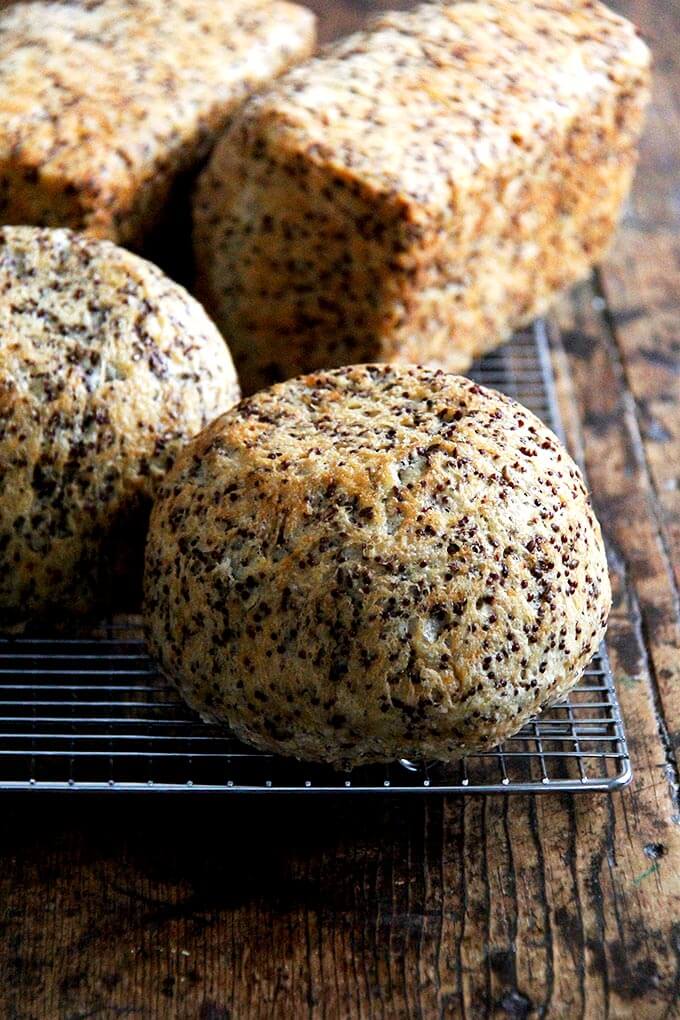
In the fall of 2016, I posted a recipe for curried apple and egg salad. It was pictured piled atop slices of quinoa-flax bread, a recipe I couldn’t yet share because it, or a variation of it, would appear in Bread Toast Crumbs the following April.
I’ve been meaning to share the recipe ever since BTC made its way into the world because it’s one of my favorites—of the 40 variations of the peasant bread included in the book, this (along with a variation of the focaccia) is the one I make most often.
Like all of the bread recipes in BTC, this one is simple—stir together dry ingredients, add wet, mix to form a sticky dough ball. There is no need to cook the quinoa before adding it to the dough, and I love how it, along with the flax seed, punctuate the loaves with red and brown specks, offering the loveliest crunch throughout.
I prefer making 1.5 times the recipe in BTC and baking it in loaf pans, because we go through it so quickly: my husband and I toast this bread for breakfast nearly every day—it’s so filling and satisfying.
As always: for best results use a scale to measure the ingredients. More than anything else, a scale will make bread baking a breeze.
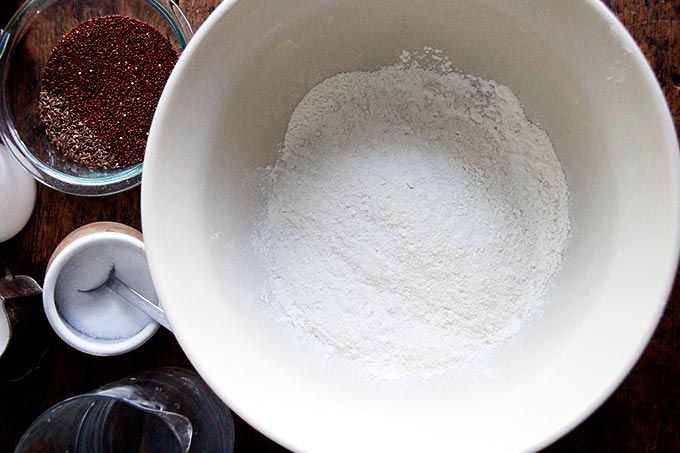
Here’s how you to make this quinoa-flax bread: Gather your ingredients: flour, salt, sugar, instant yeast, quinoa, flax, lukewarm water, and oil. Stir together dry ingredients, add wet, mix to form a ball.
Quinoa and flax seeds. No need to cook the quinoa ahead of time. I don’t rinse it anymore either. I love using the red quinoa because it looks so pretty in the finished loaf, but you can use any kind of quinoa you have on hand.
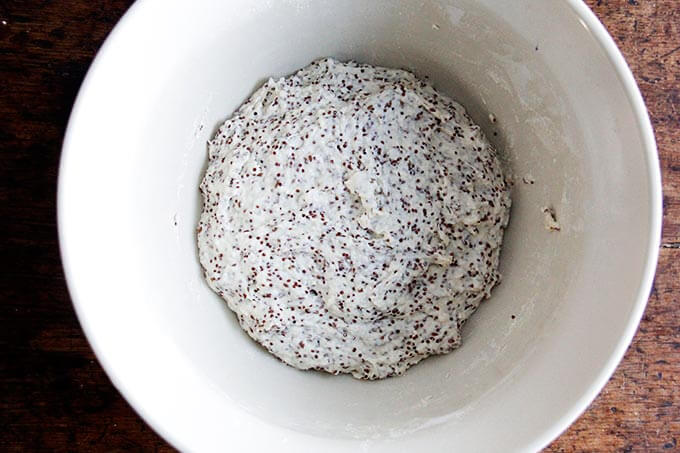
The mixed dough should be wet and sticky but should be able to hold together in a rough ball.
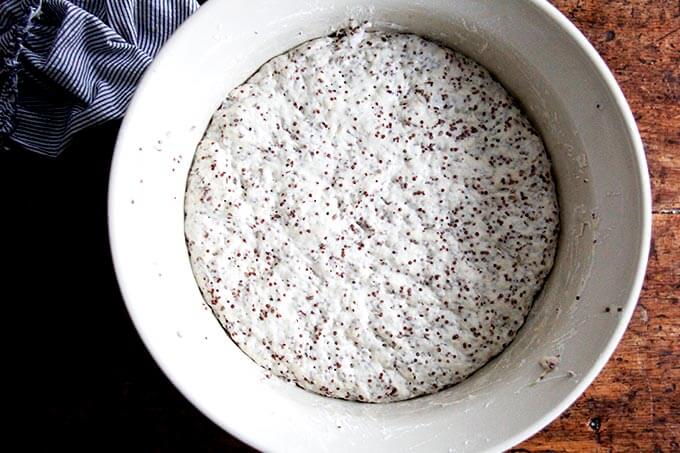
Let it rise:
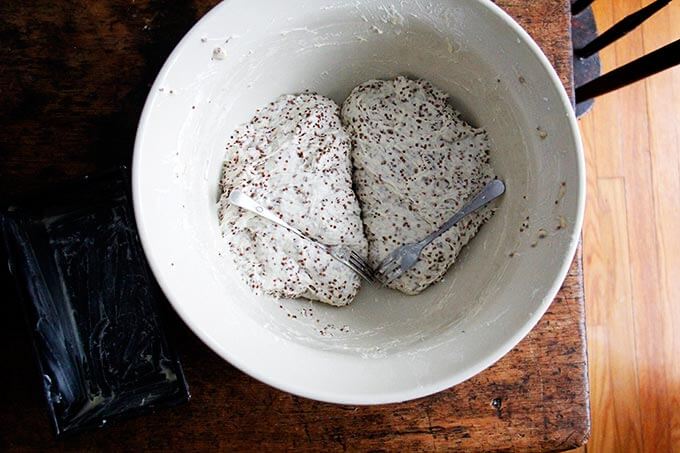
Divide the dough:
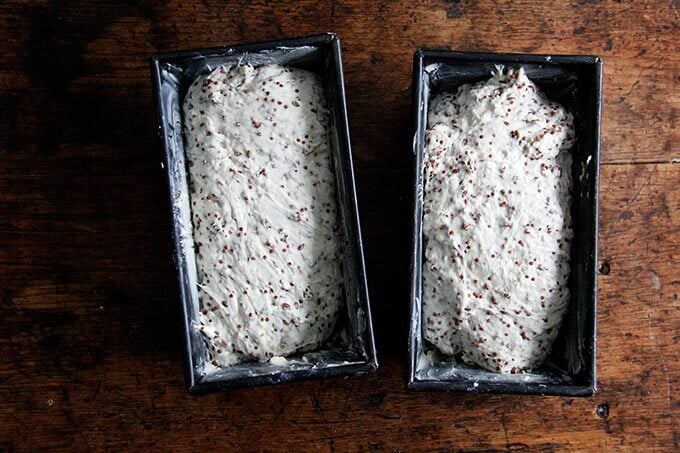
Place in buttered loaf pans:
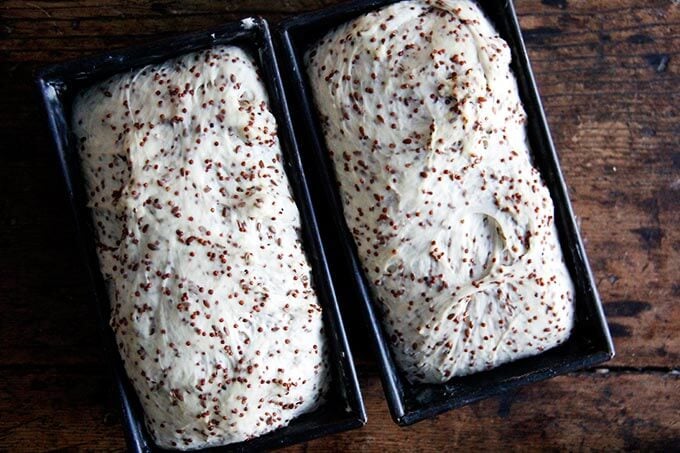
Let it rise again:
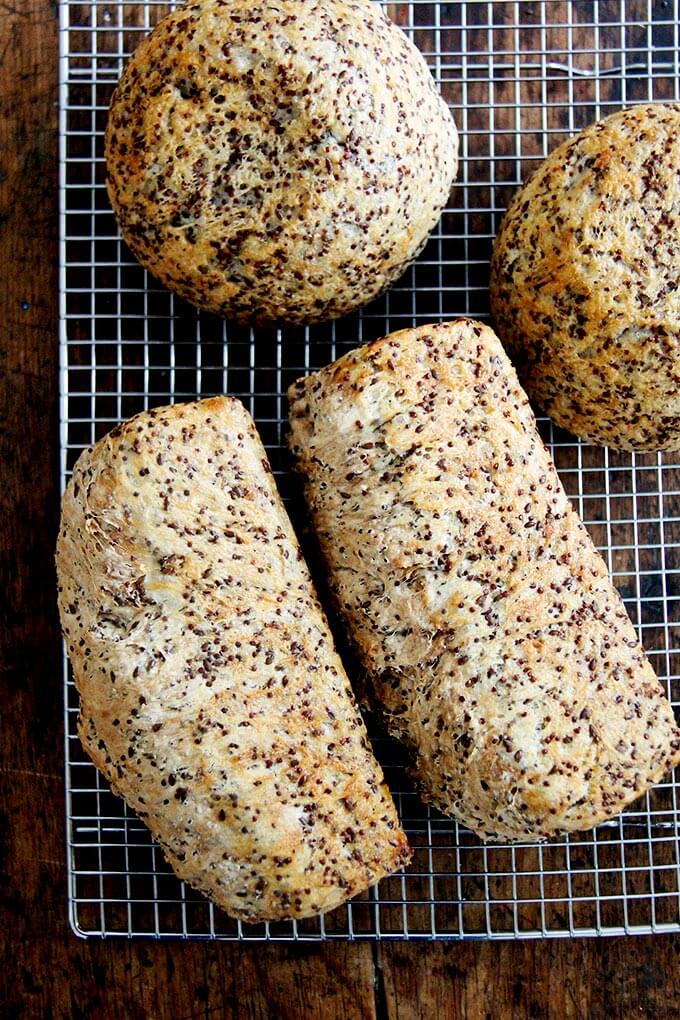
Bake it:
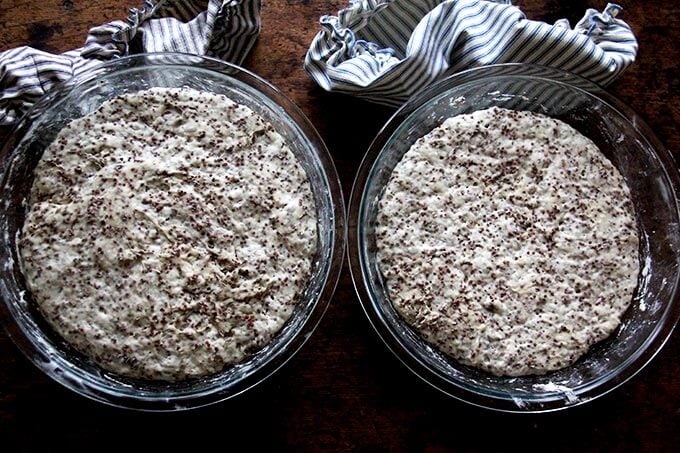
Here’s another step-by-step visual guide. This dough I mixed at night before going to sleep, so I used cold water and 1 teaspoon yeast. On the left is the dough destined for loaf pans; on the right is the dough destined for Pyrex bowls. Tip: You can do the long (12 to 18 hours), overnight rise with any bread you bake by simply cutting back the yeast to 1/2 or 1 teaspoon and using cold water in place of lukewarm—just keep in mind that the second rise will take much longer. You have to be patient—when the dough crowns the rim of the vessel it is in, it’s ready for the oven.
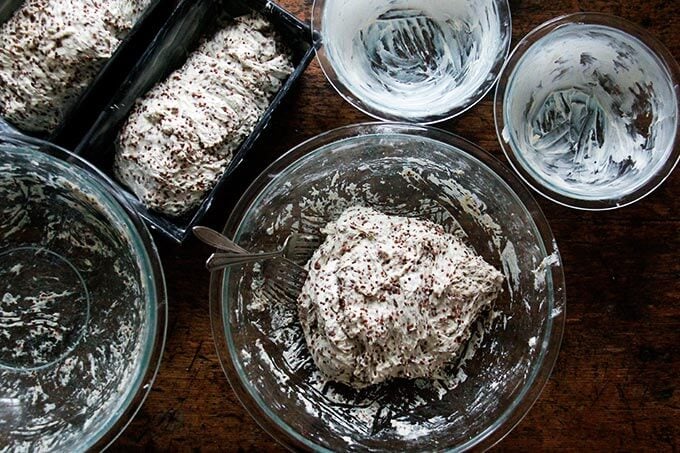
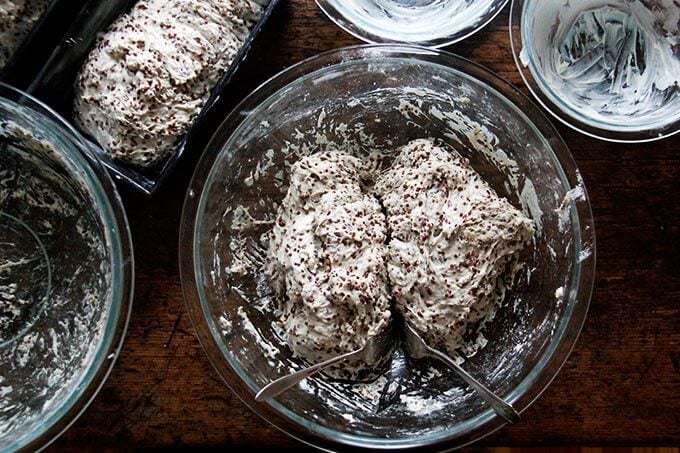
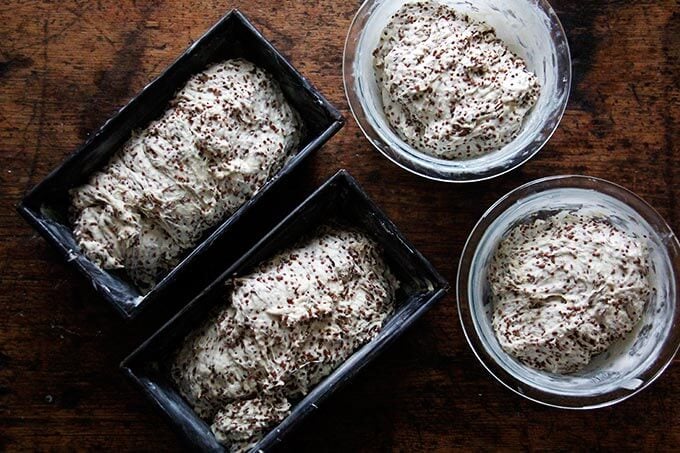
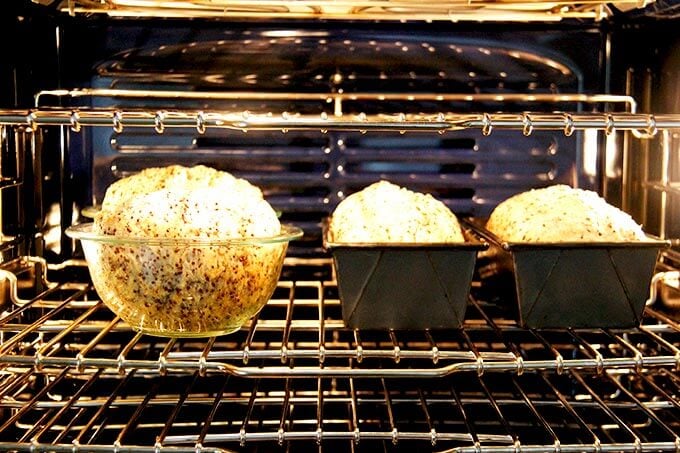
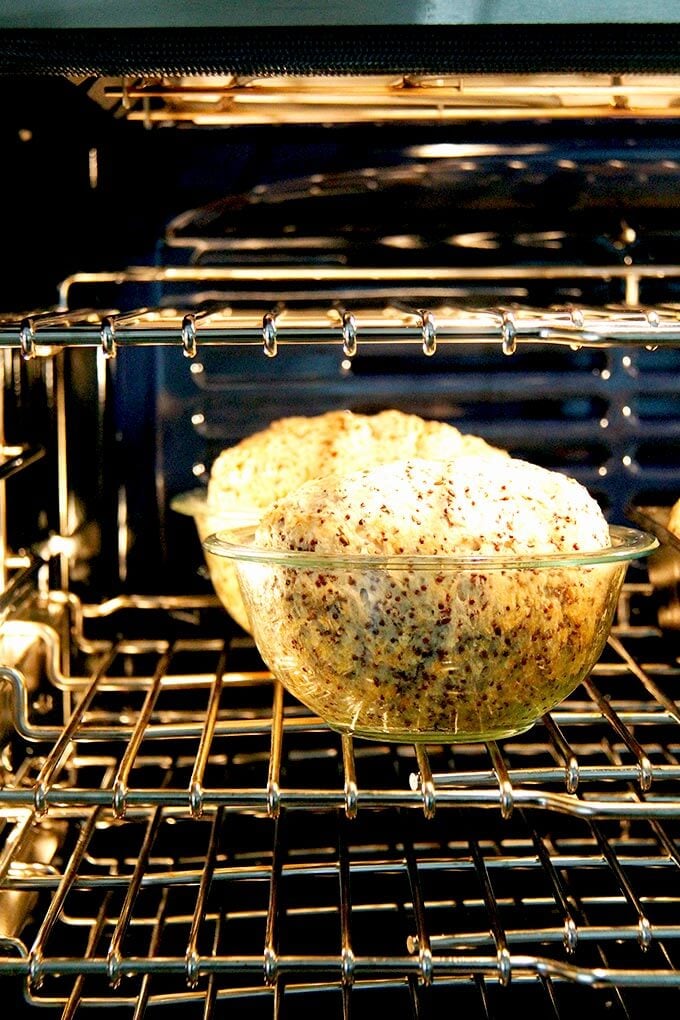
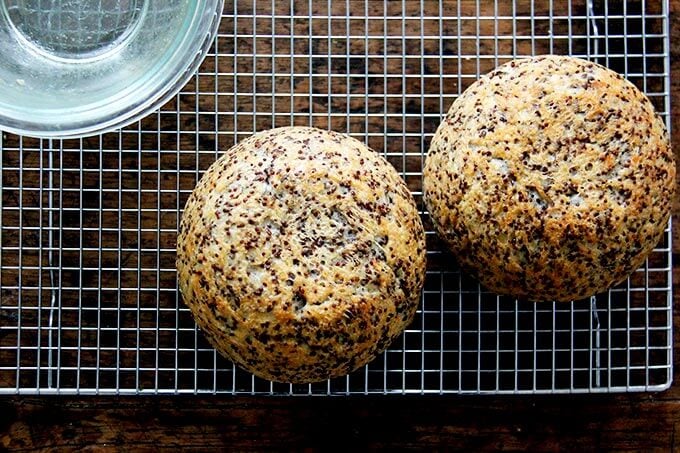
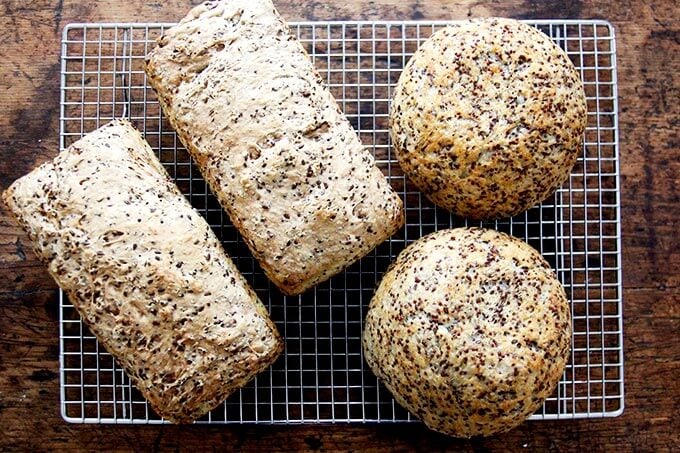
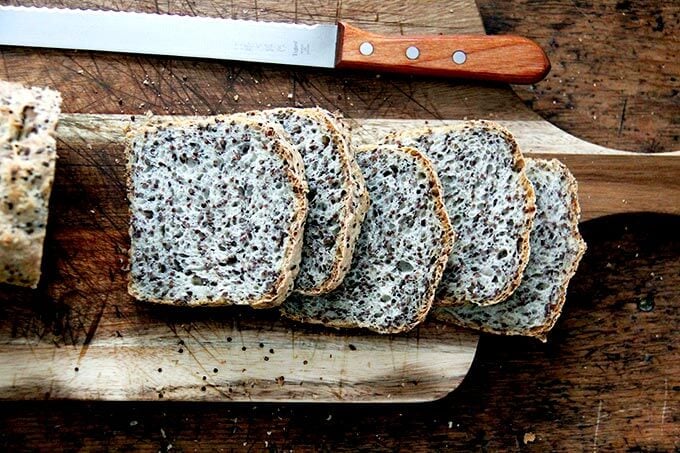
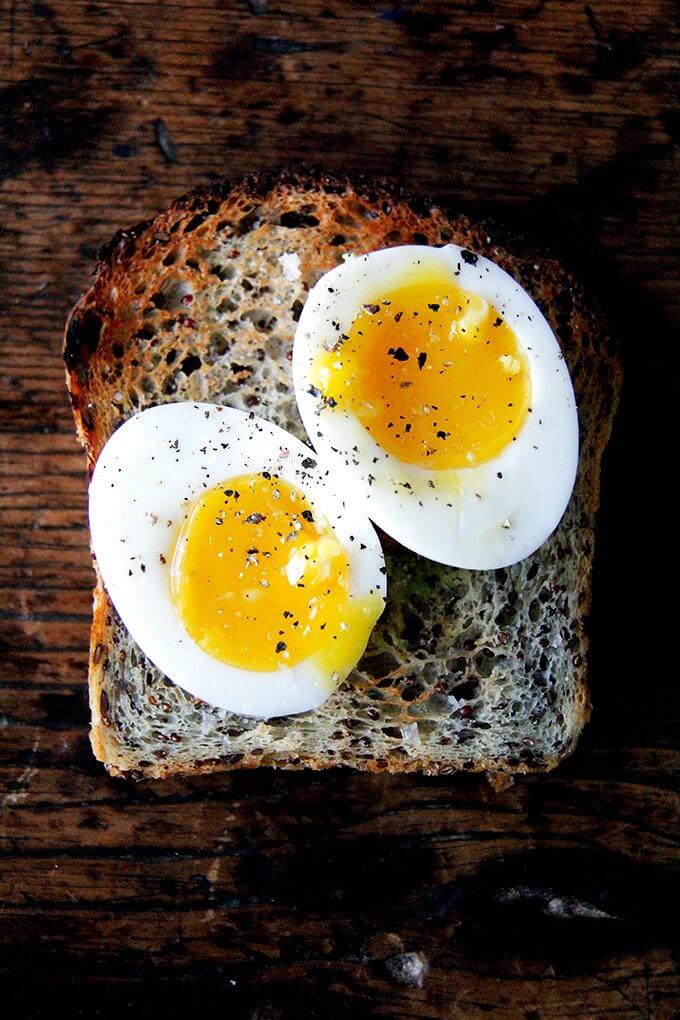
Delicious with soft-boiled eggs:
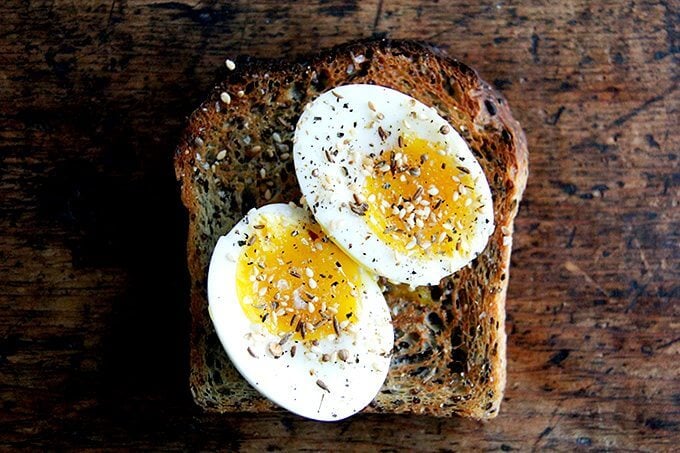
And a pinch of dukkah:
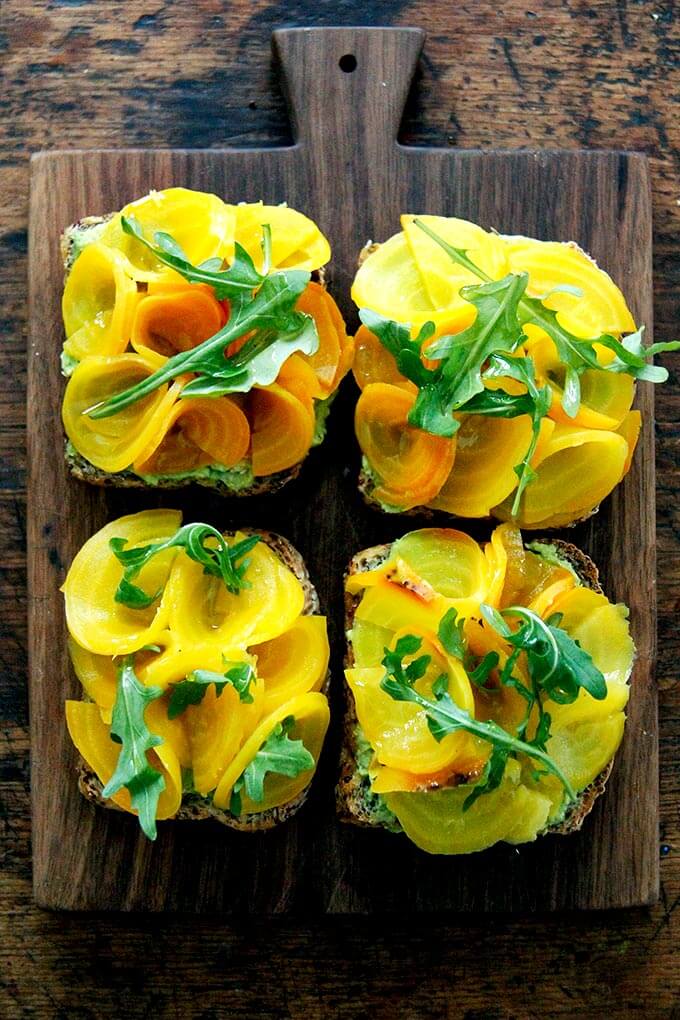
Also delicious as the base of a beet and avocado tartine:
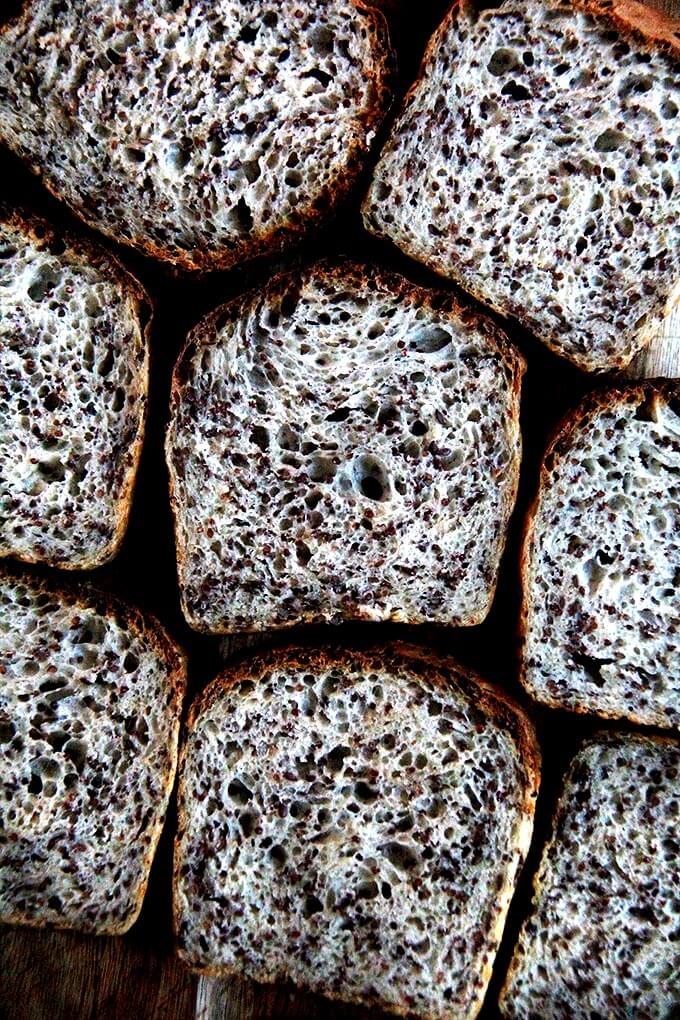
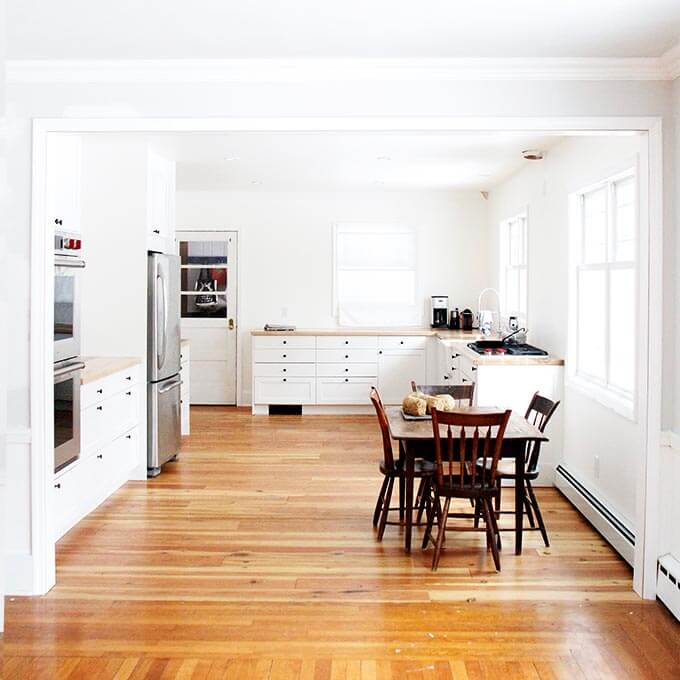
Bread in the kitchen! Almost there … waiting on the hood and some shelves and some molding. I’ll keep you posted. Update: Kitchen is done: Kitchen Reveal.
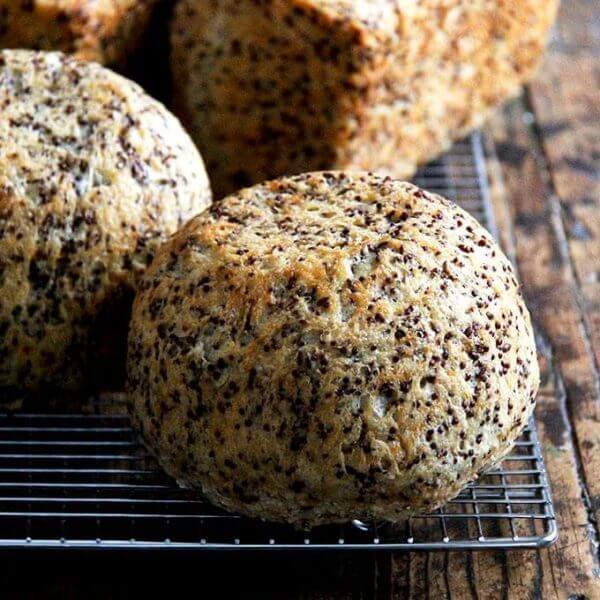
Quinoa and Flax Toasting Bread
- Total Time: 3 hours 45 minutes
- Yield: 2 loaves
Description
Adapted from my cookbook, Bread Toast Crumbs.
This is essentially 1.5 times the recipe in BTC. It’s baked in two buttered loaf pans (as opposed to two Pyrex bowls). I love it toasted for breakfast smeared with butter and salt or almond butter — it’s so filling and satisfying. See notes below for baking it in 2 Pyrex bowls.
* To create a warm place for your dough to rise, preheat your oven for 1 minute, then shut it off—you should be able to place your hands on the oven grates; it should be about 100ºF.
Ingredients
- 6 cups (768 g) unbleached all-purpose flour
- 1 tablespoon (15 g) kosher salt
- 1 tablespoon (12 g) sugar
- 2½ teaspoons (10 g) instant yeast
- 3/4 cup (132 g) red quinoa
- ¼ cup + 2 (52 g) tablespoons flax seed
- 3 cups (681 g) lukewarm water, made my combining 2.25 cups cold water with .75 cups boiling water
- 1/3 cup (66 g) olive oil
- 2 to 3 tablespoons softened butter
Instructions
- In a large bowl, whisk together the flour, salt, sugar, and instant yeast. Add quinoa and flax seeds and toss to coat. Add the water followed by the oil. Using a rubber spatula, mix until the flour is absorbed and the ingredients form a sticky dough ball.
- Cover bowl with a damp tea towel or plastic wrap and set aside in a warm spot* to rise for 1½ to 2 hours or until the dough has doubled in bulk.
- Preheat the oven to 375ºF. Grease two loaf pans with the softened butter—be generous. Using two forks, deflate the dough by releasing it from the sides of the bowl and pulling it towards the center. Rotate the bowl quarter turns as you deflate, turning the mass into a rough ball as you bring it towards the center.
- Using your two forks and working from the center out, separate the dough into two equal halves. Use the forks to lift each half of dough into the prepared pans. If the dough is too wet to transfer with forks, lightly grease your hands with butter or oil, then transfer each half to bowls. Let the dough rise for 20 to 30 minutes on the countertop near the oven (or other warm, draft-free spot) or until the top of the dough just crowns the rim of the pans.
- Bake for 40 to 45 minutes or until golden all around. Remove bowls from oven and turn loaves out onto cooling racks. If the loaves look pale or feel soft, return them to their pans, and bake 5 minutes longer. Remove from oven, turn out onto cooling rack, and let cool for at least 15 minutes before cutting.
Notes
If using two buttered Pyrex bowls, use these proportions:
- 4 cups (512 g) unbleached all-purpose flour
- 2 teaspoons kosher salt
- 2 teaspoons sugar
- 2¼ teaspoons instant yeast
- ½ cup red quinoa
- ¼ cup flax seed
- 2 cups lukewarm water, made my combining 1.5 cups cold water with .5 cups boiling water
- 1/4 cup olive oil
- 1 to 2 tablespoons softened butter
- Prep Time: 3 hours
- Cook Time: 45 minutes
- Category: Bread
- Method: No-Knead
- Cuisine: American
This post may contain affiliate links. Please read my disclosure policy.

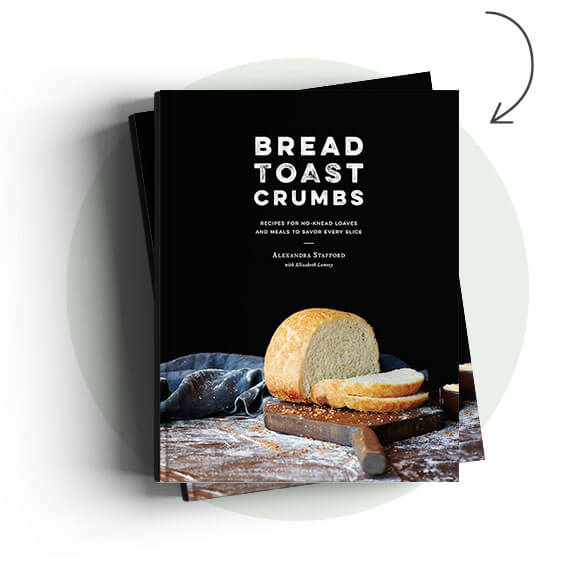

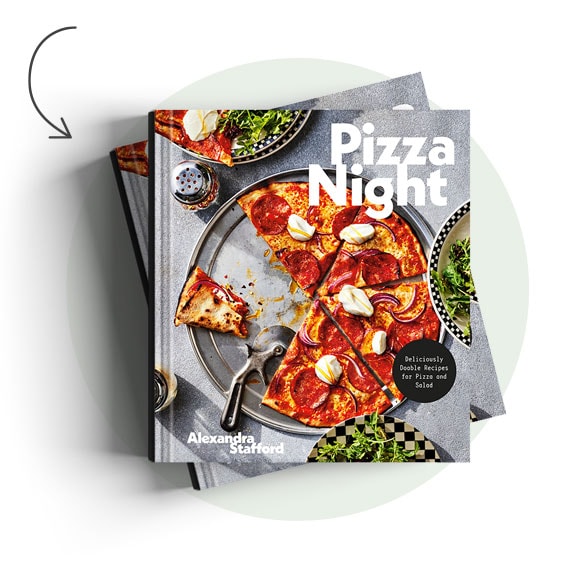
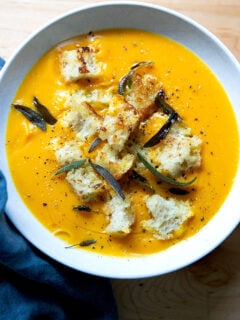
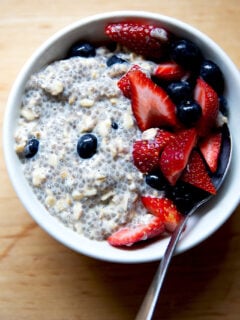
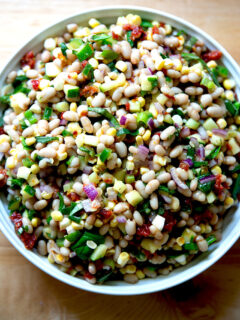
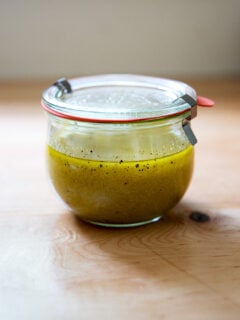
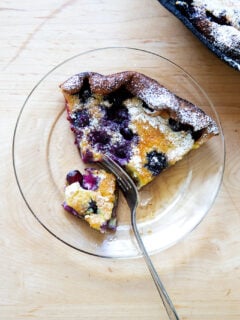
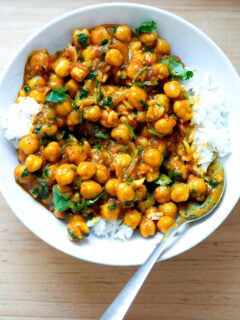

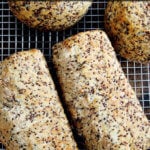
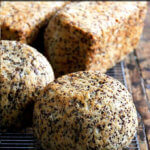
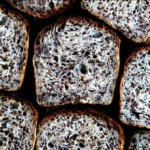
183 Comments on “Quinoa and Flax Toasting Bread”
Even my white bread loving grand-daughter had 2 slices. I accidentally left out the olive oil the second time I made it and got a much higher rise than the first time. Not sure I will use the oil in future batches
Wonderful to hear this, Mira! And to be honest, I don’t think the oil is necessary here. The more I bake, the more I simplify recipes, and so often I find less is more 😍
This is SO good, and surprisingly easy to make. My family loves it. I baked the whole recipe as one loaf in a 13-inch pullman plan. It’s absolutely lovely for avocado toast, for peanut butter topped with bananas or blueberries, for mascarpone topped with sliced strawberries, or just plain with butter with or without jam. Thanks so much for the recipe!
I forgot to leave it 5 stars.
Wonderful to hear this, Gretchen! Thanks so much for writing. And thanks for rating it, too 💕
Hi Alexandra,
Quick question for you! i don’t have red quinoa, only the regular white/brown one. is that okay to use instead? looking forward to trying this!
might also have to pick up your book to grab that rye recipe! thanks!
Hi Christine! So sorry for the delay here … yes: white quinoa is totally fine! And yay re book 😍
Hello Ali!
Hello from Montréal, Québec!
I have recently discover you website, and it is fabulous, I just love it!
For this recipe can I use ground flax seeds ? that’s all I have, and I am really anxious to try this bread recipe.
Thank you!
Hi Lou! Thank you for the kind words … means a lot 🙂 🙂 🙂
I have never used ground, but I don’t see why you couldn’t … I would imagine the ground flax might impart even more flavor. Give it a go!
Firstly, I’d like to say that I am obsessed with your blog! I am so glad I stumbled across it, its an amazing resource.
I was just wondering, I only own 1 9×5 loaf pan. If I want to make this bread in that size pan, should I just use 1 times the recipe rather than upping it to the 1.5?
Thank you Ali!
So nice to hear this, Prudence! Thank you 🙂
I would make half the recipe: so 3 cups flour, 1.5 teaspoons kosher salt, etc.
Question: For the long (12-18 hour) overnight rise mentioned in this post, are your referring to a room temperature or a refrigerated rise? If you were referring to a room temp rise, then I would really like to know how to adjust the yeast and time period for a long, refrigerated rise. Do you have any idea how to do this? Would you still use cold water? Thanks.
Hi Marilyn!
For a fridge rise: keep everything the same: use the same amount of yeast; use lukewarm water. Immediately after you mix up the dough, cover it and transfer it to the fridge. If you have a bowl with a lid, use it. Otherwise, plastic wrap or a cloth bowl cover will work. If I’m not using a lid, I like to rub the dough with oil to prevent it from forming a crust on the top layer in the fridge. You can keep the dough in the fridge for over 24 hours before baking it. Keep in mind, once you transfer the dough to the prepared pans/bowls, the second rise may take longer due to the refrigeration.
Let me know if you have any other questions!
Can this bread be baked in a dutch oven? I don’t have two loaf pans or pyrex bowls so I am wondering what I could use instead. Really looking forward to trying this recipe!
Hi Lauren! Yes, you can: be sure to butter it very well. You may need to add 10-15 minutes of baking time since you are baking such a large loaf in 1 vessel.
I tried this out tonight and it was delicious! I am already looking forward to eating it for breakfast (and probably lunch and dinner) tomorrow. I preheated my oven with the dutch oven in it, then took it out and lined it with parchment and plopped the whole dough in. I baked it for 45 minutes with the lid on and then another 15 minutes or so with the lid off for the top to get nice and brown. 5 star recipe!
Oh awesome! Great to hear that method worked!! Thanks so much for reporting back with your method and results.
Thanks for the reply! And – if I’m not splitting the dough in two, what should i do to it before the second rise?
I would shape the dough into a rough ball if possible using flour as needed. Transfer it to your baking vessel. Then let it rise until it nearly doubles. Does that make sense?
i’ve done this in the dutch oven a couple of times with good results – thank you for posting this! a q for you though – did you do a second rise? i’ve skipped it and it came out good – but very dense – wondering if a second rise would help.
Hi Gabrielle! Great to hear. Yes, a second rise will definitely help prevent the dough from being dense. The second rise may take 45 minutes to an hour depending on the time of year and the temperature of your kitchen.
i notice with interest that you call it toasting bread. Is the structure sound enough to use it for sandwiches for lunches, or must it be toasted for the best effect
Hi Rosemary! It definitely can be used as sandwich bread, but I just find it makes especially good toast because it’s so hearty.
I made this bread and loved it! Thank you. Next time I’d like to use some whole wheat or white whole wheat flour. Have you tried that? Any thoughts on amount? I’m thinking maybe 25%. Wondering what your experience is. Thank you for sharing all your delicious recipes!
So great to hear this, Maria! I think you will have great success substituting in 25% whole wheat flour or white whole wheat flour. That is the percentage I always recommend people begin with; then based on your result, you can add more or less next time around. Happy baking! Thanks for writing 🙂
Hi Alexandra, is it possible to remove the flax seeds in the recipe and replace the amount with quinoa instead? My mother finds that the flax seeds too hard on her teeth. Or is it easier to just leave out the flax seed amount?
Yes, absolutely Christina! Go for it!
I’ve baked this bread 3 times already and every time the result is amazing. After reading the comments, I have made a few changes to the recipe. For 1 loaf, I used 300g of all purpose flour and 84g of amaranth flour – tastes so good! Also, a splash of oil does trick. My entire family is now cooking/baking your recipes 🥰 Thank you so much!
Oh yay! So wonderful to hear this, Luciana! Amaranth flour sounds wonderful. I’ll have to try that soon. Thanks so much for writing 🙂 🙂 🙂
Good morning
Re quinoa flax bread – What size loaf pan would I use ? 8×4 “ ?
Thanks
Nancy
Hi Nancy, yes! That would be fine or slightly larger: 8.5 x 4.5 inches or 9 x 5 inches.
For me personally, the quinoa flavor was a bit too strong and I didn’t get much flavor from the bread. Do you think this would work with hemp seed and flax seed instead? How can I get a more yeast-y bread-y flavor?
Hi Melissa! Sure, try hemp instead. Hemp won’t give the bread a crunch, but it will still add flavor and will give the bread a boost of nutrition.
Regarding yeasty flavor, I’m not sure how to advise. I wouldn’t recommend adding more yeast, because I think too much yeast can add an unpleasant flavor. I’m not quite sure how to answer this one.
Thank you for the recipe from sunny Singapore!
I used 25%wholewheat and toasted white sesame & it came out smelling heavenly!! I’ve baked it twice within 3 days cos my husband loved it and insisted that I baked to give to his friends!
Wonderful to hear this, Ailin! Thanks so much for writing. Toasted sesame seeds sound divine!!
Hi. Do you wash the quinoa to get rid of the soapy taste first? Thanks
Hi! I don’t but if you are used to doing this, then go for it. You can’t harm it!
I haven’t always had perfect success with all your peasant bread variations (the fault is mine because a lot of them when I’m patient and focused are out of this world good ie. those brioche buns) but this one was excellent. Really delicious! Light but nice and grainy.
I love your blog so much. Everything is so fresh and uncomplicated. I often just come here for inspiration and don’t comment nearly as much as I should but some of your recipes are staples for me now (like lentils with spinach on yogurt).
So nice to hear all of this, J! Thanks so much for writing and commenting. Wonderful to hear about the lentils and spinach with yogurt too … I go through phases where I make that twice a week. Simple, nourishing, and tasty. Thanks again for writing!
Can whole wheat flour be used in this bread?? TIA
I wouldn’t use 100% whole wheat flour. I always suggest starting small. So here, I’d suggest doing 2 cups (256 g) whole wheat flour and 4 cups (512 g) bread flour or ap flour. After you make it once, you can up the amount to 3 cups whole wheat flour, etc.
This recipe and the maple oatmeal bread have become staples in my house. I sometimes use part millet or amaranth seeds. I never baked bread before the pandemic, but now it is hard to return to supermarket bread. I’ll have to put a few extra loaves in the freezer before my kitchen renovations start.
So nice to hear this, Mira! Thanks so much for writing. Also: yay for a kitchen renovation!! So exciting 🙂 🙂 🙂
Made this yesterday for the first time and realized, after I’d already begun, that I was out of flax seeds. Subbed in hemp hearts, and the results are deliciously nutty and flavorful!
Oh yay! Wonderful to hear this, Kate. I have hemp hearts on hand for my smoothies but I’ve never added them to bread … will try this soon! Thanks so much for writing and sharing your notes 🙂 🙂 🙂
I reviewed this almost 18 months ago– and have been making either this bread or the oatmeal maple bread in your book almost weekly. Decided I needed to update my review to add my husband’s contented sigh “Great toast” and my grandson’s demand “I need toast” ( and refusal to share). Good thing this bread is so easy to make. I highly recommend using a scale to weigh the flour, and I find a bread whisk the easiest way to mix the dough.
So wonderful to hear all of this, Mira! Thanks so much for taking the time to review the recipe again and to share your anecdotes… so sweet 🙂 🙂 🙂 I can’t believe this, but I’ve never used a bread whisk! Going to order one now. Thank you 🙂
Hi Alexandra
I have made this bread many times – love it especially toasted!
Can you answer a question for me – how can so many measurements for all purpose flour on various sites vary so widely. One recipe says 480 gm another says 560. This is a huge discrepancy. It has me puzzled and wondering what I’m missing. I have started to measure with cups again as I don’t trust that the measurements are accurate. I measure in cups and record in grams for next time. Thanks for your insight.
Nancy Cook Belwood Ontario
Hi Nancy! So nice to hear this. I love this one toasted, too 🙂
So, the wide variation in flour measurements is because everyone has their own standard. For instance, one cup of flour for me is 128 grams. That’s the standard I use, so 4 cups of flour weigh 512 grams. King Arthur Flour has a different standard and Dorie Greenspan has another, etc. I do advise sticking with the gram measurements when given, however, because the baker that created the recipe likely want you to use that precise amount. Sarah Keiffer, for example, whose recipes I love love love, uses a different standard than I do for 1 cup of flour, but I always use her weight measurements because I know they will be accurate.
Hope that helps!
Hello Alexandra
I have made this bread many times and love it. Can I sub white whole wheat flour for the all purpose flour? In your experience can you use white whole wheat flour Cup for cup and get the same results ? I’d like to understand the science behind white whole wheat flour vs regular white all purpose flour. Thank you so much.
Nancy
Hi Nancy! I always recommend starting with 50% whole wheat flour; then adjusting from there with more or less depending on how you like the results. If you want to learn more about white whole wheat flour specifically, this post will be helpful: https://alexandracooks.com/2016/04/07/king-arthur-flours-white-whole-wheat-flour/
Like Nancy, I would also like to sub white whole wheat flour for most if not all of the AP flour. Thoughts?
Hi Lee! You can try it. I have had great luck using white whole wheat flour. That said, the texture will be a little denser, so just manage your expectations about the texture. Lots of people don’t mind a denser whole wheat bread, but if are after something really light, I wouldn’t recommend using 100% white whole wheat flour. You could also always start with 50% white whole wheat; then increase from there depending on how you like the results.
Can I make this bread without using quinoa? If so, what could I substitute?
Yes, absolutely! Either simply omit it or you can use another seed such as sesame or pumpkin or sunflower or any combination of seeds you like.
Hello Ali, I just made this and it’s my new favorite! I appreciate the ease and added nutrition of this recipe. My loaf sunk down the center while baking, did I overproof? Thanks so much for sharing your recipes and expertise?
Hi Barb! Great to hear you liked it. Regarding the sinking, It’s possible you overproofed it. It’s also possible that you’re using too much water. Are you using a scale to measure the water and flour? If so, next time, hold back 50-75 grams of water. You can always add it slowly if the dough seems dry. What type of flour are you using?
Hi Ali, I halved everything so used 288 g of King Arthur AP flour and 96 g of KA white whole wheat, 341 g of water. Next bake I’ll increase to 50% white whole wheat. I’ll hold back on the water and see what happens. Here in Nashville, TN, pimento cheese is very popular. This bread is divine with pimento cheese, it’s addictive. Thanks for your advice!
So wonderful to hear this, Barb! I love pimento cheese, and that combination sounds lovely. Thanks so much for writing and sharing your notes — so helpful for others!
I am obsessed with these little round loaves of no knees bread. I have made the peasant bread several times. With the quinoa and flax bread may I substitute chia seeds? I have a ton of those at home and I only have ground flax seeds. I’ll do whatever you suggest.
Great to hear, Sarah! I have not tried, but I imagine chia would be great! Go for it 🎉
Love your book and all the recipes in it. I have always made your recipes with all purpose flour as indicated. I was a user of the bread machine and graduated. Don’t get me wrong we enjoyed homemade bread just another way. So my question is what happens if you use bread flour?
So nice to hear this, Diane 🙂 🙂 🙂 Bread flour will be wonderful here. Go for it!
Ali, I’ve made a few different bread recipes from yours and this one is the best so far. The first loaf disappeared in a day, perfect like you said with breakfast but also with a hot chilli bowl for lunch.
So nice to hear this, Alain! Thanks so much for writing and sharing. Hard to be hot chili & good bread 🙂 🙂 🙂
Could I use red quinoa for this recipe? I’ve got some I need to use up:)
Oops! Just went back and looked at the recipe and it literally calls for red quinoa! Can’t wait to try this soon!
Glad you found it, Clare! Hope you love it!
Want to try your bread!